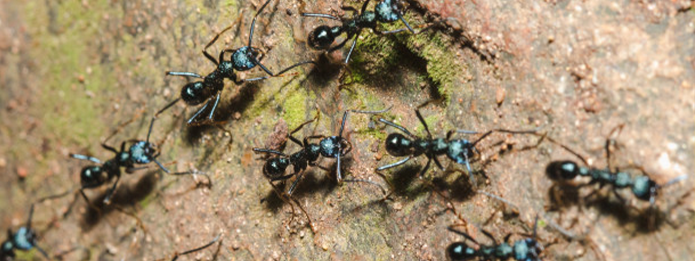How are Carpenter Ants Different From Other Ants

Ant infestations can be notoriously difficult to eliminate. It’s helpful to act as soon as possible, at the first signs of an ant invasion. Identifying and understanding the type of ants in your home is also key to successfully getting rid of them. Carpenter ants are an especially problematic type of ant that can seriously damage your home if not detected and removed right away.
Identifying Carpenter Ants
Most of us tend to think that all ants look alike. While this is true to some degree, there are clear differences between different types of ants that are easy to spot upon a closer investigation. Taking the time to look closely and identify the specific variety of ant in your home is an important first step toward eradicating any ant invasion. With carpenter ants, however, early identification is especially important given the destructive nature of these ubiquitous pests.
- Size: Carpenter ants are large, ranking among North America’s largest ants. Most carpenter ants are around 0.25 inches (0.64 cm), though worker ants can often grow as long as 0.5 inches (1.27 cm) and the queen can measure a whopping 1.0 inch (2.54 cm) long.
- Colour: These ants can be brown, black, reddish-brown, brownish-yellow, or even black and brown together.
- Antennae: All ants have two antennae protruding from their heads. Some ants have antennae that look like straight lines. Carpenter ants’ antennae, however, always have a “bent” shape that is similar to a bent elbow.
- Other Features: Carpenter ants can have wings, but not all carpenter ants have wings. They also have heart-shaped heads and large jaws that are easily visible.
Why Are Carpenter Ants Such a Problem?
Carpenter ants’ most distinguishing characteristic is the same one that makes them so troublesome for homeowners. These ants use their large, powerful jaws to bite and chew through wood, creating vast, impressive networks of tunnels.
While they can live outdoors, they will also gladly move indoors and tunnel through the wood in your home, making them particularly notorious pests. If undetected, carpenter ants can cause significant and expensive damage to furniture, molding, and trim work. Worse, they can also tunnel through the wooden framework inside your walls, creating structural weaknesses that are extremely difficult and costly to repair.
Carpenter ants are widespread throughout Canada and are active year-round. They are most prolific in the springtime as they search for nesting sites, though a bout of winter weather can cause them to seek shelter indoors.
Signs That You Have a Carpenter Ant Infestation
Contrary to popular belief, carpenter ants don’t eat wood. They bite and chew wood for tunnel-building purposes only and spit out all the wood they chew. This spit-out wood looks like sawdust and is known as “frass.” Frass on your home’s floor is the biggest tell-tale sign that at least one colony of carpenter ants is likely nesting within your house. Dead ants nearby are another sign of infestation: Carpenter ants tend to remove the bodies of dead ants from the tunnel networks.
How Truly Nolen Can Help
Carpenter ants often create significant damage because they are difficult to detect until the problem is severe. The ants tend to stay entirely hidden from view, building their tunnels and nests deep inside walls or trim. Worse, carpenter ants usually create multiple nests, making finding and eliminating all ants even harder for homeowners.
Truly Nolen offers custom, effective solutions for carpenter ant pest control in Cambridge. Our professional pest experts are experienced at identifying all nest locations in and around your home and creating a custom treatment plan to eradicate the infestation. If you suspect carpenter ants are invading your home, contact us today to schedule an inspection.